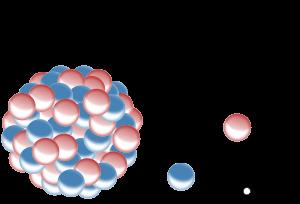In nuclear physics, beta decay (β decay) is a type of radioactive decay in which a beta particle (an electron or a positron) is emitted from an atomic nucleus. Beta decay is a process which allows the atom to obtain the optimal ratio of protons and neutrons.Beta decay is mediated by the weak force. There are two types: beta minus and beta plus. In the case of beta decay that produces an electron emission, it is referred to as beta minus (β−), while in the case of a positron emission as beta plus (β+).An example of β− decay is shown when carbon-14 decays into nitrogen-14:146C → 147N + e− + νeNotice how, in electron emission, an electron antineutrino is also emitted. In this form of decay, the original element has decayed into a new element with an unchanged mass number A but an atomic number Z that has increased by one.An example of positron (β+ decay) is shown with magnesium-23 decaying into sodium-23:2312Mg → 2311Na + e+ + νeIn contrast to electron emission, positron emission is accompanied by the emission of an electron neutrino. Similar to electron emission, positron decay results in nuclear transmutation, changing an atom of a chemical element into an atom of an element with an unchanged mass number. However, in positron decay, the resulting element has an atomic number that has decreased by one.Emitted beta particles have a continuous kinetic energy spectrum, ranging from 0 to the maximal available energy (Q), which depends on the parent and daughter nuclear states that participate in the decay. The continuous energy spectra of beta particle occurs because Q is shared between the beta particle and a neutrino. A typical Q is around 1 MeV, but it can range from a few keV to a few tens of MeV. Since the rest mass energy of the electron is 511 keV, the most energetic beta particles are ultrarelativistic, with speeds very close to the speed of light.Sometimes electron capture decay is included as a type of beta decay (and is referred to as "inverse beta decay"), because the basic process, mediated by the weak force is the same. However, no beta particle is emitted, but only an electron neutrino. Instead of beta-plus emission, an inner atomic electron is captured by a proton in the nucleus. An example of electron capture involves krypton-81 becoming bromine-81 and producing an electron neutrino:8136Kr + e− → 8135Br + νeThis type of decay is therefore analogous to positron emission (and also happens, as an alternative decay route, in all positron-emitters). However, the route of electron capture is the only type of decay that is allowed in proton-rich nuclides that do not have sufficient energy to emit a positron (and neutrino). These may still reach a lower energy state, by the equivalent process of electron capture and neutrino emission.




Comment
0